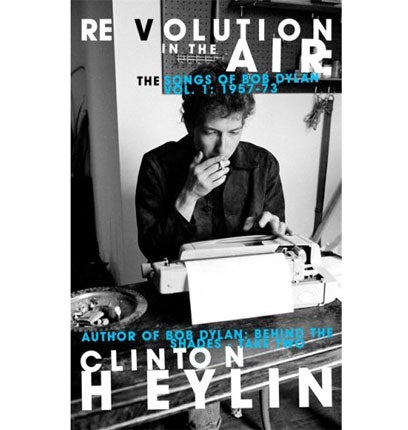Revolution in the Air, By Clinton Heylin
Another book about Bob for the bonfire

Your support helps us to tell the story
From reproductive rights to climate change to Big Tech, The Independent is on the ground when the story is developing. Whether it's investigating the financials of Elon Musk's pro-Trump PAC or producing our latest documentary, 'The A Word', which shines a light on the American women fighting for reproductive rights, we know how important it is to parse out the facts from the messaging.
At such a critical moment in US history, we need reporters on the ground. Your donation allows us to keep sending journalists to speak to both sides of the story.
The Independent is trusted by Americans across the entire political spectrum. And unlike many other quality news outlets, we choose not to lock Americans out of our reporting and analysis with paywalls. We believe quality journalism should be available to everyone, paid for by those who can afford it.
Your support makes all the difference.The largest type on a messy cover is reserved for the author's name and "praise for Clinton Heylin". For Heylin, "No one has quite met the challenge of documenting every one of [Bob Dylan's] songs".
He suggests "a big bonfire of 'books about Bob'. Too many have been written by the chronically misinformed, the mercenary and the magpie." So into the pyre go Christopher Ricks, Wilfrid Mellers, Greil Marcus, Robert Shelton and hundreds of others. Suze Rotolo's charming memoir is "only fleetingly informative and woefully edited". Even Dylan's own books don't escape unsinged. Meanwhile, Heylin's own back pages – portentous, ill-disciplined – are, of course, repeatedly commended.
Heylin's avowed purpose is a "just the facts" history of every Dylan song: this volume covers 1957-1973. Though the author, a magpie himself, is light on sources, one credited and credible source is the Columbia/Sony studio log. As to Dylan's manuscripts, the circumstances of their writing are largely down to surmise and anecdote.
Theory is presented as fact, and Heylin writes about events to which he was not privy. Who can say what went on between Dylan and Joan Baez in the first flush of love? Pages are spent musing over where and when "Mr Tambourine Man" was started and finished. Judy Collins does not claim it was written at her house, as Heylin states. As she told me, she was staying at his manager's house in Woodstock and heard Dylan working on it there.
Then there are the "facts" behind "The Lonesome Death of Hattie Carroll": William Zan(t)zinger was not wearing a diamond ring, Carroll was not "slain by a cane" but died of a heart attack. Anyway, Dylan – unlike Heylin – never bothered to check his facts and wrote one of his most powerful songs after reading an account in Broadside. Or so we are told, by an author who hasn't heard of poetic licence. Heylin's next book will reveal "the untold story of Shakespeare's sonnets". Let's hope Ricks, Stanley Wells, Jonathan Bate et al are marshalling their arguments.
Join our commenting forum
Join thought-provoking conversations, follow other Independent readers and see their replies
Comments